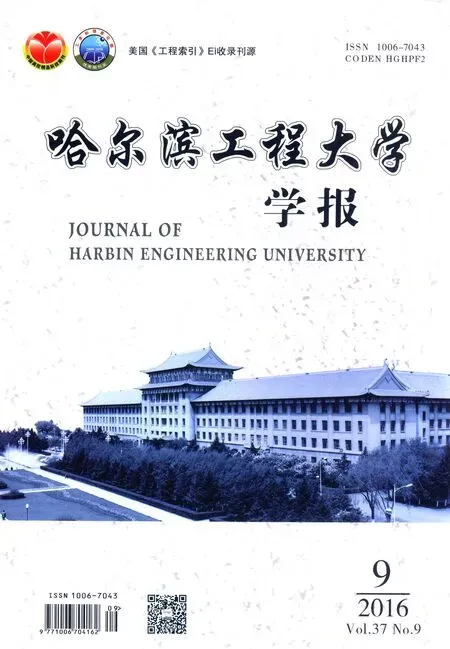改进微粒群算法反演参与性介质辐射物性
齐宏,陈琴,任亚涛,阮立明
(哈尔滨工业大学 能源科学与工程学院,黑龙江 哈尔滨 150001)
改进微粒群算法反演参与性介质辐射物性
齐宏,陈琴,任亚涛,阮立明
(哈尔滨工业大学 能源科学与工程学院,黑龙江 哈尔滨 150001)
为了准确、快速地反演参与性介质的辐射物性,本文利用有限体积法(FVM)求解频域辐射传递方程获得的反射及透射信号的振幅信息,结合扩散微粒群(RPSO)、吸引扩散微粒群(ARPSO)以及变异的吸引扩散微粒群(MARPSO)三种智能优化算法,同时反演了激光辐照下各向同性散射的一维均匀平板介质的衰减系数、单次散射反照率。在其他条件均相同的情况下,吸引扩散微粒群(ARPSO)所需的计算时间相比于其他两种算法有明显的降低。使用ARPSO在存在误差情况下进行了反演,发现即使在测量误差为10%时,其反演参数的最大相对误差不超过5%,说明该算法鲁棒性较好。
辐射反问题;吸引扩散微粒群算法;频域辐射传输方程;有限体积法;辐射物性
近年来,由于短脉冲激光在工程以及生物领域的应用,瞬态辐射反问题的研究吸引了国内外众多学者的注意[1-3]。参与性介质内辐射物性的反演可以通过时域或者频域测量来完成。相较于时域测量技术,频域测量具有设备简单、测量速度快、信号分辨率高等优点[4]。鉴于频域测量技术的高效性与经济性,频域反问题模型有很广阔的应用前景。目前,大量研究方法已经成功应用于辐射反问题的研究,如Gauss-Newton法[5],Levenberg-Marquardt法[6]及共轭梯度法[7-8]。然而,这些所有基于传统梯度方法的算法均有各自的局限性[9]:1)这些方法总是难以找到全局最优解,2)计算速度和计算结果准确度有限,3)这些方法必须基于目标函数的导数,4)当这些方法应用于病态逆问题时,优化过程将更加复杂。群体智能优化算法与传统的梯度方法相比具有很大的优势,如不依赖初值的选取、不需要计算目标函数的导数以及对于病态问题和非线性问题有很强的适用性。
微粒群算法(particle swarm optimization, PSO)是1995年由Kennedy等[10]提出的一种群体智能优化算法。由于其物理概念简单、预设参数较少等优点,近几年广泛的应用于系统辨识、神经网络训练、多目标优化等多个领域[11]。
然而对于求解大量非线性、不可微和多峰值的复杂优化问题,PSO算法容易产生过早收敛的问题,其原因主要是种群的多样性较低。因此在搜索过程中增加种群的多样性对于复杂问题的求解是有帮助的。本文将几种改进的微粒群算法应用于频域辐射反问题中,同时反演了一维参与性介质的衰减系数、单次散射反照率,对几种算法的结果进行了对比。
1 微粒群算法
标准微粒群算法(PSO)的基本过程为:首先在求解区域内随机分布粒子,每个粒子代表一个问题的初始解。通过迭代搜索得到区域内粒子的最优位置。在每次迭代时都会得到两个极值位置,即局部最优值与全局最优值。然后各个粒子根据最优值调整自己的飞行速度从而得到问题的解。微粒群算法的核心在于每一代粒子的速度更新算法。假设第i个微粒表示为Xi(t),速度为Vi(t),其经历过的最优位置记为Pi(t),群体所有微粒经历过的最优位置记为Pg。对每一代,其速度与位置更新方程如下[10]
(1)
(2)

1.1扩散微粒群算法(RPSO)
Kyun等[12]提出了扩散微粒群算法(RPSO)。RPSO算法引入了粒子之间的扩散效应,因此对于复杂搜索区域的问题具有更好的适应性。RPSO与标准PSO的不同点在于其速度更新方程右侧加入了随机速度项,以增强其探索其他区域的能力避免其陷入局部收敛。
(3)
式中:Vr表示一个随机的速度;c3为加速常数;r3为在[0,1]范围内变化的随机数。新加入的速度随机项c3r3wVr可以增强粒子探索新区域的能力。
1.2吸引扩散微粒群算法(ARPSO)
Riget等[13]提出保证种群多样性的吸引扩散微粒群算法(ARPSO)。该算法的速度进化方程为:
(4)
其中,
(5)
(6)
1.3 变异的吸引扩散微粒群算法(MARPSO)
陈保娣等[14]在ARPSO基础之上,提出了另一种种群多样性度量方法,其种群多样性定义如下:
(7)
(8)
式中:δ表示全局最优位置邻域的半径。
速度进化方程表示为
(9)
(10)
为了保证算法的局部收敛性能,还引入了速度和位置变异策略。
(11)
(12)
2 正问题模型及验证
2.1正问题
对于阶跃脉冲激光辐照下的一维各向同性散射介质,其无量纲的瞬态辐射传输方程可以表示为[15]
(13)
(14)
(15)

介质左侧受到阶跃脉冲激光的照射,对于单个阶跃脉冲有:
(16)

边界条件可表示为:
(17)
(18)
本文采用有限体积法(FVM)求解上述频域辐射传输方程,其中,半球透射比和反射比的幅值定义为:
(19)
(20)

2.2模型正确性验证


图1 半球反射与透射信号幅值随无量纲频率变化曲线Fig.1 The amplitude of hemispherical reflectance and transmittance
3 计算结果及讨论
本文采用3种改进的微粒群算法(扩散微粒群算法、吸引扩散微粒群算法以及变异的吸引扩散微粒群算法)对上述一维频域辐射模型中的衰减系数b以及散射反照率w进行反演。
反演过程中所需要测量的量为边界处的反射信号与透射信号幅值,通过使目标函数小于一预先设定的小值e来得到所需反演的真实物性。目标函数定义为:
(21)

3.1频域辐射信号对频率的敏感度分析
敏感度系数是敏感度分析的一个重要参数,采用差分格式的敏感度系数可以表示如下:
(22)



图2 不同脉冲宽度下反射信号与透射信号振幅对衰减系数β 的敏感性Fig.2 The sensitivity of the reflectance and transmittance to extinction coefficient β under different incident pulse widths

图3 不同脉冲宽度下反射信号与透射信号振幅对散射反照率w的敏感性Fig.3 The sensitivity of the reflectance and transmittance to extinction coefficient w under different incident pulse widths
3.2计算结果分析


以下计算中考虑测量值取正问题模型计算值加随机的测量误差。即
(23)
(24)


表2 无量纲频率*=10时3种算法的反演效果

表3 无量纲频率*=20时3种算法的反演效果

表4 不同频率下的测量误差对于ARPSO反演结果的影响

图4 3种算法目标函数值随着微粒群代数的变化Fig.4 The fitness of the three algorithms in the function of iterations
4 结论
本文利用有限体积法求解了频域辐射传递方程,通过其得到的反射及透射信号的振幅信息,结合扩散微粒群(RPSO)算法、吸引扩散微粒群(ARPSO)算法以及变异的吸引扩散微粒群(MARPSO)算法三种智能优化算法同时反演了激光辐照下各向同性散射的一维均匀平板介质的衰减系数β以及单次散射反照率ω。
3)使用ARPSO在存在误差情况下进行了反演,发现即使在测量误差为10%时,其反演参数的最大相对误差不超过5%,说明该算法鲁棒性较好。而且无量纲频率越大其所需计算时间越短。
[1]QI Hong, RUAN Liming, ZHANG Haochun, et al. Inverse radiation analysis of a one-dimensional participating slab by stochastic particle swarm optimizer algorithm[J]. International journal of thermal sciences, 2007, 46(7): 649-661.
[2]CHOPADE R P, MOHAN V, MAYANK R, et al. Simultaneous retrieval of parameters in a transient conduction-radiation problem using a differential evolution algorithm[J]. Numerical heat transfer, part A: applications, 2013, 63(5): 373-395.
[3]ZHANG Biao, QI Hong, REN Yatao, et al. Application of homogenous continuous Ant Colony Optimization algorithm to inverse problem of one-dimensional coupled radiation and conduction heat transfer[J]. International journal of heat and mass transfer, 2013, 66: 507-516.
[4]FRANCOEUR M, VAILLON R, ROUSSE D R. Theoretical analysis of frequency and time-domain methods for optical characterization of absorbing and scattering media[J]. Journal of quantitative spectroscopy and radiative transfer, 2005, 93(1/2/3): 139-150.
[5]MUHIEDDINE M, CANOT É, MARCH R. Heat transfer modeling in saturated porous media and identification of the thermophysical properties of the soil by inverse problem[J]. Applied numerical mathematics, 2012, 62(9): 1026-1040.
[6]HUANG C H, WANG C H. The design of uniform tube flow rates for Z-type compact parallel flow heat exchangers[J]. International journal of heat and mass transfer, 2013, 57(2): 608-622.
[7]LU Shuai, HENG Yi, MHAMDI A. A robust and fast algorithm for three-dimensional transient inverse heat conduction problems[J]. International journal of heat and mass transfer, 2012, 55(25/26): 7865-7872.
[8]AN Wei, RUAN Liming, QI Hong. Inverse radiation problem in one-dimensional slab by time-resolved reflected and transmitted signals[J]. Journal of quantitative spectroscopy and radiative transfer, 2007, 107(1): 47-60.
[9]QI Hong, RUAN Liming, SHI M, et al. Application of multi-phase particle swarm optimization technique to inverse radiation problem[J]. Journal of quantitative spectroscopy and radiative transfer, 2008, 109(3): 476-493.
[10]KENNEDY J, EBERHART R. Particle swarm optimization[C]//Proceedings of IEEE International Conference on Neural Networks. Perth: IEEE, 1995: 1942-1948.[11]肖人彬. 面向复杂系统的群集智能[M]. 北京: 科学出版社, 2013.
[12]LEE K H, BAEK S W, KIM K W. Inverse radiation analysis using repulsive particle swarm optimization algorithm[J]. International journal of heat and mass transfer, 2008, 51(11/12): 2772-2783.
[13]RIGET J, VESTERSTRØM J S. A diversity-guided particle swarm optimizer-the ARPSO[R]. Technical Report 2000-02. Denmark: University of Aarhus, 2002.
[14]陈保娣, 曾建潮. 改进的吸引扩散微粒群算法[J]. 控制理论与应用, 2010, 27(4): 451-456.
CHEN Baodi, ZENG Jianchao. Modified attractive and repulsive particle swarm optimization[J]. Control theory & applications, 2010, 27(4): 451-456.
[15]ROUSSE D R. Numerical predictions of short-pulsed laser transport in absorbing and scattering media. II-A frequency-based approach[J]. International journal of computational fluid dynamics, 2007, 21(9/10): 369-375.
本文引用格式:
齐宏,陈琴,任亚涛,等. 改进微粒群算法反演参与性介质辐射物性[J]. 哈尔滨工程大学学报, 2016, 37(9): 1244-1249.
QI Hong, CHEN Qin, REN Yatao,et al. Inversion of radiative physical properties of participatory media using improved particle swarm optimization[J]. Journal of Harbin Engineering University, 2016, 37(9): 1244-1249.
Inversion of radiative physical properties of participatory media using improved particle swarm optimization
QI Hong, CHEN Qin, REN Yatao, RUAN Liming
(School of Energy Science and Engineering, Harbin Institute of Technology, Harbin 150001 China)
To accurately and quickly invert the radiative property of a participatory medium, in this study, we apply the finite volume method (FVM) to obtain amplitude information regarding reflection and transmission signals by solving the frequency-domain radiation transfer equation. We used three particle swarm optimization (PSO) methods, i.e., repulsive PSO, attractive and repulsive PSO, and modified attractive and repulsive PSO, to simultaneously invert the attenuation coefficient and single scattering albedo of a one-dimensional homogeneous slab medium. The results show that the computation time of the attractive and repulsive PSO (ARPSO) is significantly lower than those of the other two algorithms. The maximum relative errors of the retrieved parameters were less than 5% even with a 10% measurement error, which demonstrates the algorithm is robust.
inverse radiation problem; attractive and repulsive particle swarm optimization; frequency domain radiation transfer equation; finite volume method; radiative physical property
2015-07-10.
时间:2016-08-29.
国家自然科学基金项目(51576053).
齐宏(1980-), 男, 教授, 博士生导师.
齐宏,E-mail: qihong@hit.edu.cn.
10.11990/jheu.201507030
TK730
A
1006-7043(2016)09-1244-07
网络出版地址:http://www.cnki.net/kcms/detail/23.1390.u.20160829.0827.006.html

